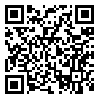Tue, Apr 1, 2025
[Archive]
Volume 37, Issue 1 (2-2023)
Med J Islam Repub Iran 2023 |
Back to browse issues page
Download citation:
BibTeX | RIS | EndNote | Medlars | ProCite | Reference Manager | RefWorks
Send citation to:



BibTeX | RIS | EndNote | Medlars | ProCite | Reference Manager | RefWorks
Send citation to:
Safarnavadeh M, Ghanbari M, Salehi L. Dietary Fiber Intake and Related Factors in Community-Based Iranian’s Elderly. Med J Islam Repub Iran 2023; 37 (1) :602-609
URL: http://mjiri.iums.ac.ir/article-1-8621-en.html
URL: http://mjiri.iums.ac.ir/article-1-8621-en.html
Department of Health Promotion and Education, & Research Center for Health, Safety and Environment, Alborz University of Medical Sciences, Karaj, Iran , leilisalehi@abzums.ac.ir
Abstract: (863 Views)
Background: There are considerable documents suggesting that inadequate fiber intake (FI) is a key risk factor for various chronic diseases. The aim of this study was to investigate Dietary FI in the Persian elderly.
Methods: This descriptive-analytic study was performed to investigate FI in a sample of the elderly who received free services from healthcare centers in Karaj, Iran. For sampling method: at first, the names of 36 centers were written on small pieces of paper and poured into a container, then another person was asked to randomly select the names of 10 centers, then referring to each of the centers and preparing a list of elderly people, the study subjects were selected, The study was conducted between September 2018, and April 2019Several questionnaires were used to collect data regarding DF: characteristics, daily FI , knowledge, SE (self-efficacy), perceived benefits, and barriers towards FI as well as stage of readiness of FI. t-test and ANOVA were used to compare independent mean values. Data were checked for normality before analysis by using Kolmogorov-Smirnov (K-S) test to check data normality.
Results: Totally of 400 elderly individuals entered the study with the average amount of fiber per day. The data analysis indicated they did not know the recommended intake of at least 25 gr each day. feeling less hungry and fiber’s price was the most frequent perceived benefits and barriers towards FI , respectively. Gastrointestinal diseases (P < 0.001), smoking (P < 0.001), and perceived barriers (P < 0.001), were statistically significant independent positive predictors of FI.
Conclusion: The findings of the current study indicated that FI among elderly people in Iran was very low and varied a great by gender, education, marital status, income level, employment status, smoking, stage of change, and gastrointestinal disease.
Methods: This descriptive-analytic study was performed to investigate FI in a sample of the elderly who received free services from healthcare centers in Karaj, Iran. For sampling method: at first, the names of 36 centers were written on small pieces of paper and poured into a container, then another person was asked to randomly select the names of 10 centers, then referring to each of the centers and preparing a list of elderly people, the study subjects were selected, The study was conducted between September 2018, and April 2019Several questionnaires were used to collect data regarding DF: characteristics, daily FI , knowledge, SE (self-efficacy), perceived benefits, and barriers towards FI as well as stage of readiness of FI. t-test and ANOVA were used to compare independent mean values. Data were checked for normality before analysis by using Kolmogorov-Smirnov (K-S) test to check data normality.
Results: Totally of 400 elderly individuals entered the study with the average amount of fiber per day. The data analysis indicated they did not know the recommended intake of at least 25 gr each day. feeling less hungry and fiber’s price was the most frequent perceived benefits and barriers towards FI , respectively. Gastrointestinal diseases (P < 0.001), smoking (P < 0.001), and perceived barriers (P < 0.001), were statistically significant independent positive predictors of FI.
Conclusion: The findings of the current study indicated that FI among elderly people in Iran was very low and varied a great by gender, education, marital status, income level, employment status, smoking, stage of change, and gastrointestinal disease.
Type of Study: Original Research |
Subject:
Health
Send email to the article author
| Rights and permissions | |
 |
This work is licensed under a Creative Commons Attribution-NonCommercial 4.0 International License. |








